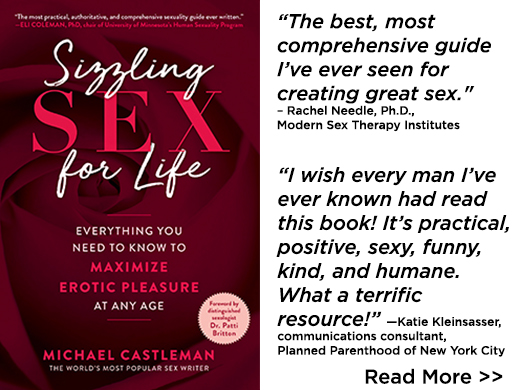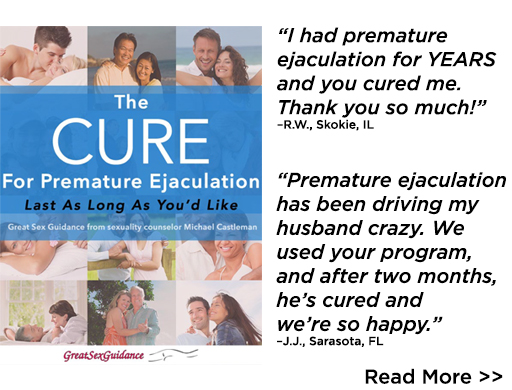
Popular culture embraces “sex addiction,” but most psychologists reject it. When we say they’re “addicted” to bacon, Beyoncé’s music or The Simpsons, it’s largely in jest. We’re not actually addicted. We just really like whatever.
But when behavioral “addiction” meets sexuality—particularly some men’s frequent masturbation to porn—many see a crisis as grave as drug addiction. In fact, “sex addiction” usually has little to do with truly out-of-control sex—and everything to do with the guilt and shame some people feel about being sexual, particularly men who stroke to porn.
A Brief History of “Sex Addiction”
In 1976, while working with sex offenders, addiction counselor Patrick Carnes, Ph.D., noticed that their discussions of sex resembled drug addicts’ descriptions of substance abuse. Carnes coined the term “sex addiction.” In 1983, he published Out of the Shadows: Understanding Sexual Addiction, the field’s manifesto. It spawned today’s multi-million-dollar-a-year sex-addiction-treatment industry.
Carnes treated “sex addiction” as his own insight. Actually, it’s a contemporary update of what used to be called “perversion,” any sex the self-appointed arbiters of decency considered unacceptable: “excessive” erotic fantasies, “excessive” sex, almost any sex with sex workers, and most solo sex, especially when it involves porn. “Perversion” implied immorality, but today only around 25 percent of Americans embrace traditional religious morality, so “perversion” has lost its sting. Proponents of sex-addiction “medicalized” perversion by calling it “addiction.”
Sex addiction struck a chord with social conservatives, religious fundamentalists, anti-porn feminists, much of the media, twelve-step veterans with sexual issues, some mental health researchers and clinicians, and women upset about their men’s porn habits.
Researchers flocked to study the affliction. Before 1985, psychology journals published very few mentions of “sex addiction” or “compulsivity.” By 2017, three decades later, articles numbered more than 12,000. The field even boasts its own journal, Sexual Addiction and Compulsivity, founded by Patrick Carnes.
Sex addiction gained the spotlight when celebrities shamefully—and very publically—admitted they were sex addicts, usually to bolster legal positions during messy divorces: actors Charlie Sheen and David Duchovny, and golfer Tiger Woods.
Celebrity confessions attracted media—and not just supermarket tabloids. The New York Times first mentioned sex addiction in 1980. By 2007, the term had appeared in dozens of articles.
“Sex addiction” flooded the Internet. I searched—37 million hits.
Treatment programs proliferated and a new psychotherapeutic specialty emerged, certified sex addiction therapist (CSAT), a credential awarded by an organization founded by Patrick Carnes.
Finally, neuroscientists jumped on the sex-addiction bandwagon. Many studies showed that “excessive,” “compulsive” sex triggered neurological changes identical to those experienced by drug addicts—sharp spikes in brain levels of the neurotransmitter, dopamine.
Truly “Addictive”?
“Addiction” was once reserved for drug dependence: tobacco, alcohol, heroin, and now, opioid pain medications. Medically, addictions must meet four criteria:
- Tolerance. The more you use, the more you need.
- Craving. Addicts experience such intense desire that they organize their lives around their substance.
- Withdrawal. If addicts stop using, they suffer debilitating symptoms.
- Increasingly severe consequences. Addictions risk of job loss, family destruction, severe illness, and death.
The top “sex addiction” involves stroking to porn, so I use the terms “sex” and “porn” addiction synonymously.
The vast majority of people called “sex” or “porn” “addicts” don’t meet these criteria.
- No tolerance. If porn caused tolerance, over time, users would have to consume increasing amounts. But according to PornHub, the world’s largest porn site, most viewers (75 percent of them male) watch less than five minutes per visit and 86 percent spend less than 20 minutes. Only 0.2 percent watch more than two hours at a time. Now some men might visit several times a day or download videos for later viewing. But there’s no evidence that porn-watching causes tolerance. Only two porn-viewers per 1,000 watch more than two hours a day, Meanwhile, most Americans watch television more than that. Are we a nation of TV addicts?
Carnes contends that as their addictions intensify, sex addicts become tolerant to “conventional” porn, and seek more “extreme” imagery. But there is no normal amount or type of sex, so what’s “conventional” or “extreme?” To the sex-addiction industry, “extreme” porn includes anal play, BDSM, swinging, group sex, and public sex, and a good deal of homosexuality. Actually, these are all fairly prevalent, involving tens of millions of otherwise mentally healthy Americans.
Many men begin with one type of porn, then sample others. That’s not tolerance. It’s usually curiosity or boredom. After viewing the most “extreme” porn, almost all men can still get off watching one lone couple doing it in the missionary position. No tolerance.
- No craving. There’s a big difference between craving and enjoying. The vast majority of men enjoy porn, but only a tiny fraction organize their lives around it. Drug addicts have difficulty going a day without their substances. But if men have something better to do, they don’t watch porn. Visits to PornHub drop substantially for all major holidays and sporting events. Most men enjoy porn, but don’t develop cravings suggesting addiction.
- No withdrawal. When sports fans—mostly men—have responsibilities that preclude watching games, they feel bummed, but don’t suffer debilitating symptoms. For almost all men, the same is true for porn. When it’s available, they watch. When it’s not, they may feel wistful, but function fine without it.
- No increasingly severe consequences. The main consequence of watching porn is the pleasure of orgasm. But two pitfalls are possible:
- A small proportion of porn-using men develop erectile dysfunction (ED). This usually results not from watching porn, per se, but from the anxiety, guilt, and shame they feel about masturbating to it. This issue is usually not porn but stress.
- Some women catch men wanking to porn and threaten nasty consequences, including divorce. But since the late-1990s when porn exploded on the Internet, the divorce rate has declined. No credible evidence suggests that viewing porn leads more than a tiny fraction of men to increasingly severe negative consequences.
Most Psychologists Reject “Sex Addiction”
Here’s the irony of “sex addiction.” As the term becomes deeply embedded in popular culture, most psychologists have rejected the idea. The bible of mental health disorders is the American Psychiatric Associations’ Diagnostic and Statistical Manual (DSM), first published in 1952. Early editions pathologized “excessive” sexual activity. But as a mountain of research has demonstrated the enormous diversity of normal, healthy sexuality, the professional consensus has shifted to the view that “sex addiction” is little more than a myth.
DSM machinations may appear arcane, but hundreds of millions of dollars a year are at stake. DSM recognition means insurance reimbursement for treatment.
For DSM-V (2013), thousands of stakeholders reviewed tens of thousands of studies. The sex-addiction industry lobbied to include “excessive,” “out-of-control,” “hypersexual” “addiction” as a disorder. But they produced little credible evidence that viewing porn or unconventional sex are mental disorders.
Meanwhile, the sex-positive community countered with abundant research showing that, for the large majority of “sex addicts,” the issue is not sex, per se, but their guilt and shame about thinking and acting sexually.
DSM decision-makers rejected the sex-addiction industry’s claims. In DSM-V there is no diagnosis of “hypersexuality” or “sex addiction.”
The main organization that credentials U.S. sexuality professionals agrees. The American Association of Sex Educators, Counselors, and Therapists advises against “unduly pathologizing consensual sex.” AASECT finds “insufficient evidence to support sex/porn addiction as a mental disorder,” and calls Carnes-inspired sex addiction” treatment methods “poorly informed about sexuality.”
“Sex addiction” is largely fiction.
You may also be interested in reading The Real Problem with Pornography: It’s Bad for Sex.
———-
Part 2 explores the harm the sex-addiction industry says the affliction causes. Part 3 discusses the real prevalence of problematic sex, and how to change unwanted sexual habits without mislabeling them as ‘addictions.”
Men masturbate considerably more than women
Herbenick, D. et al. “Sexual Behavior in the United States: Results from a National Probability Sample of Men and Women Ages 14-94,” Journal of Sexual Medicine (2010) 7(suppl 5):255.
Laumann, E.O et al. The Social Organization of Sexuality: Sexual Practices in the United States, University of Chicago Press, 1994.
30 percent of Americans suffer significant anxiety
http://www.anxietycentre.com/anxiety-statistics-information.shtml
The average American watches several hours of TV per day
https://www.nytimes.com/2016/07/01/business/media/nielsen-survey-media-viewing.html
The plethora of sex/porn addiction screening tests
Reay, B. et al. “Inventing Sex: The Short History of Sex Addiction,” Sexuality & Culture (2013) 17:1.
Celebrities identified as sex addicts
https://onedio.co/content/17-celebrities-who-bravely-battled-sex-addiction-12164
NY Times mentions of sex addiction
Reay, B. et al. “Inventing Sex: The Short History of Sex Addiction,” Sexuality and Culture (2013) 17:1.
Trends in academic journal articles on sex addiction.
Kraus, S.W. et al. “Should Compulsive Sexual Behavior Be Considered an Addiction?” Addiction (2016) 111:2097.
Neuroscience, dopamine, and sex addiction
Park, B.Y. et al. “Is Internet Pornography Causing Sexual Dysfunction? A Review with Clinical Reports,” Behavioral Sciences (2016) 6:17.
Even frequent porn viewing does not meet the criteria for addiction
Ley, D. The Myth of Sex Addiction. Rowman & Littlefield, Lanham, MD, 2012.





